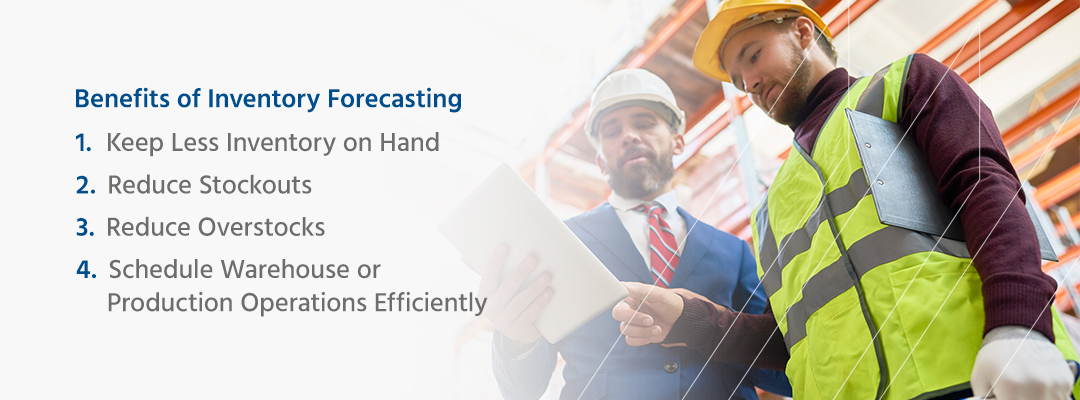Chapter 6: Accurate Forecasting
Table of Contents
-
Inventory Management Techniques in Operations Management
- Chapter 2: Relationship Management
- Chapter 3: Contingency Planning
- Chapter 4: Regular Auditing
- Chapter 5: Prioritizing With ABC Inventory Analysis
- Chapter 6: Accurate Forecasting
- Chapter 7: Average Cost Inventory Accounting
- Chapter 8: The Just-in-Time (JIT) Method
- Chapter 9: Backordering
- Chapter 10: The Economic Order Quantity (EOQ) Method
- Chapter 11: The Fast, Slow and Non-Moving (FSN) Method

While it’s impossible to predict the future, you can get very close with reliable forecasting methods. A 2020 survey revealed that 40% of retailers plan on managing their demand-supply using real-time data, and 45% said the same with inventory replenishment. Another survey revealed that demand forecasting is one of the top three most popular investments among retail and consumer goods supply chain leaders.
What Is Inventory Forecasting?
Inventory forecasting or demand planning uses historical data and ongoing trends to predict your inventory needs. You might also incorporate known events such as upcoming holidays or sales to predict demand. Sometimes demand forecasting requires extrapolation or additional data sources, especially if managing inventory for short life cycle products that do not have any sales history. Accurate inventory forecasting also factors in timing, availability and delivery speed to determine when and how much to reorder to meet expected demand.
In general, the more data sources you can account for, the more accurate your forecasts will be. Some things to look at in your forecasting include:
- Overall market and industry trends.
- Last year’s seasonal, monthly and weekly sales performance.
- Economic conditions.
- Your current and expected yearly growth rate.
- Subscriptions, presales and contracted jobs that indicate inventory you know will be needed.
- Your upcoming promotions and planned marketing spend.

What Are the Benefits of Inventory Forecasting?
Inventory and sales forecasting offer many advantages, including the following:
1. Keep Less Inventory on Hand
When you have accurate predictions guiding your reordering decisions, you can keep less safety stock. You also know which items to stock up on and which are declining in popularity. You won’t dedicate warehouse space to items that aren’t going to be in high demand. Even for your fast-moving items, you can reorder less stock more frequently because you have a predictable schedule for reordering and supplier lead times.
2. Reduce Stockouts
By predicting increased demand before it depletes your current stock, your business can reduce stockouts. Being out of stock can be costly because it means you lose sales opportunities. You may even lose customers who decide to shop from a competitor. Reducing stockouts also lets you minimize backorders and get your shipments to customers faster without delay.
3. Reduce Overstocks
You can also predict when demand will fall, letting you know you should reorder fewer products or less often. Overstocks can be just as costly because they take up valuable warehouse real estate that could go to in-demand items. Businesses often sell overstocked goods at a lower value, which creates more costs for the companies.
4. Schedule Warehouse or Production Operations Efficiently
When you know which products are moving quickly and which need to be cleared out to make room, you can schedule your operations more efficiently. You might schedule an inventory audit when you know demand will be low or cancel one when you expect demand to spike.
You’ll know when your picking team will be busier and when new orders are arriving, allowing you to schedule staff for your receiving department. If you’re involved in assembly or light manufacturing, which is often the case for electronics companies, you can schedule raw materials deliveries and production staff based on future demand.
How Can You Forecast Inventory Accurately?
Precise forecasting starts with accurate inventory tracking methods. You must know your precise stock levels to predict your future inventory needs and plan purchases faithfully. It’s also essential to have accurate and complete sales history data that incorporates all your sales channels.
Experts recommend using more than two years’ worth of historical sales and not trying to predict too far into the future. The longer the time horizon, the less accuracy you can achieve. All the sources of data you plan to use should be validated to ensure the most reliable predictions. Then you can incorporate various inventory forecasting methods, such as:
Trend Forecasting
Trend forecasting looks at trajectories in sales to predict when and how they will rise and fall. Take a given period and calculate the sales velocity of the product. If you find an upward trend, you can expect sales to continue to rise at a steady pace.
Likewise, with a downward trend, you can expect the same. It’s wise to incorporate projections with some other forecasts. For example, if you notice a spike in sales because of a recent promotion, you might expect sales to start to level out and decrease after the sale ends.
Graphical Forecasting
Graphical forecasting builds on trend forecasting to create a visual representation of the expected trends. You can also use a linear graph to examine historical and yearly sales and look for the peaks and valleys to predict when similar events will occur this year.
Qualitative Forecasting
When predicting inventory demand for short life cycle products and other stock where historical data is not useful or relevant, it helps to incorporate qualitative data. This is a common inventory forecasting technique for new ventures and companies introducing never-before-seen products. You’ll go directly to customers to evaluate potential demand. This method works best when you can incorporate market research and focus group data to flesh out your mathematical models.
The Dynamic Reorder Point Formula
Inventory control software like Finale Inventory gives you the option to automate your sales forecasting. Finale Inventory tracks your sales velocity in real time and incorporates this data into your reorder point forecasts. When you input data about your lead times and expected growth, Finale Inventory calculates how much and when to reorder based on your real-time demand trends.
If you want to use your own forecasting calculations, you can view your sales velocity on a per-product basis at any time in the analytics dashboard. To see how Finale Inventory can help you analyze your inventory data to make sound decisions, request a live demo today.




